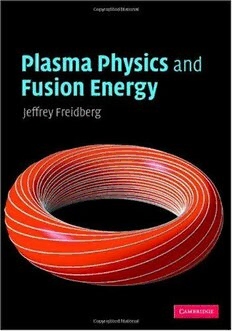
Plasma physics and fusion energy PDF
Preview Plasma physics and fusion energy
This page intentionally left blank PLASMA PHYSICS AND FUSION ENERGY There has been an increase in worldwide interest in fusion research over the last decade duetotherecognitionthatalargenumberofnew,environmentallyattractive,sustainable energysourceswillbeneededduringthenextcenturytomeettheeverincreasingdemand forelectricalenergy.Thishasledtoaninternationalagreementtobuildalarge,$4billion, reactor-scale device known as the “International Thermonuclear Experimental Reactor” (ITER). PlasmaPhysicsandFusionEnergyisbasedonaseriesoflecturenotesfromgraduate coursesinplasmaphysicsandfusionenergyatMIT.Itbeginswithanoverviewofworld energyneeds,currentmethodsofenergygeneration,andthepotentialrolethatfusionmay playinthefuture.Itcoversenergyissuessuchasfusionpowerproduction,powerbalance, andthedesignofasimplefusionreactorbeforediscussingthebasicplasmaphysicsissues facingthedevelopmentoffusionpower–macroscopicequilibriumandstability,transport, andheating. Thisbookwillbeofinteresttograduatestudentsandresearchersinthefieldofapplied physicsandnuclearengineering.Alargenumberofproblemsaccumulatedovertwodecades ofteachingareincludedtoaidunderstanding. Jeffrey P. Freidberg is a Professor and previous Head of the Nuclear Science and Engineering Department at MIT. He is also an Associate Director of the Plasma Science andFusionCenter,whichisthemainfusionresearchlaboratoryatMIT. PLASMA PHYSICS AND FUSION ENERGY JeffreyP.Freidberg MassachusettsInstituteofTechnology CAMBRIDGEUNIVERSITYPRESS Cambridge, New York, Melbourne, Madrid, Cape Town, Singapore, São Paulo Cambridge University Press TheEdinburghBuilding,CambridgeCB28RU,UK Published in the United States of America by Cambridge University Press, New York www.cambridge.org Information on this title: www.cambridge.org/9780521851077 © J. Freidberg 2007 Thispublicationisincopyright.Subjecttostatutoryexceptionandtotheprovisionof relevantcollectivelicensingagreements,noreproductionofanypartmaytakeplace without the written permission of Cambridge University Press. Firstpublishedinprintformat 2007 ISBN-13 978-0-511-27375-9 eBook(EBL) ISBN-10 0-511-27375-4 eBook(EBL) ISBN-13 978-0-521-85107-7 hardback ISBN-10 0-521-85107-6 hardback CambridgeUniversityPresshasnoresponsibilityforthepersistenceoraccuracyofurls forexternalorthird-partyinternetwebsitesreferredtointhispublication,anddoesnot guaranteethatanycontentonsuchwebsitesis,orwillremain,accurateorappropriate. For Karen Contents Preface page xiii Acknowledgements xv Units xvii PartI Fusionpower 1 1 Fusionandworldenergy 3 1.1 Introduction 3 1.2 Theexistingenergyoptions 4 1.3 Theroleoffusionenergy 16 1.4 Overallsummaryandconclusions 19 Bibliography 20 2 Thefusionreaction 21 2.1 Introduction 21 2.2 Nuclearvs.chemicalreactions 21 2.3 Nuclearenergybyfission 23 2.4 Nuclearenergybyfusion 24 2.5 Thebindingenergycurveandwhyithastheshapeitdoes 29 2.6 Summary 35 Bibliography 35 Problems 36 3 Fusionpowergeneration 37 3.1 Introduction 37 3.2 Theconceptsofcrosssection,meanfreepath,andcollision frequency 38 3.3 Thereactionrate 42 3.4 Thedistributionfunctions,thefusioncrosssections,andthefusion powerdensity 46 3.5 Radiationlosses 51 3.6 Summary 56 Bibliography 57 Problems 58 vii viii Contents 4 Powerbalanceinafusionreactor 60 4.1 Introduction 60 4.2 The0-Dconservationofenergyrelation 60 4.3 Generalpowerbalanceinmagneticfusion 62 4.4 Steadystate0-Dpowerbalance 62 4.5 Powerbalanceintheplasma 65 4.6 Powerbalanceinareactor 69 4.7 Timedependentpowerbalanceinafusionreactor 74 4.8 Summaryofmagneticfusionpowerbalance 82 Bibliography 82 Problems 83 5 Designofasimplemagneticfusionreactor 85 5.1 Introduction 85 5.2 Agenericmagneticfusionreactor 85 5.3 Thecriticalreactordesignparameterstobecalculated 86 5.4 Designgoals,andbasicengineeringandnuclearphysicsconstraints 88 5.5 Designofthereactor 91 5.6 Summary 105 Bibliography 106 Problems 106 PartII Theplasmaphysicsoffusionenergy 109 6 Overviewofmagneticfusion 111 6.1 Introduction 111 6.2 Basicdescriptionofaplasma 113 6.3 Single-particlebehavior 113 6.4 Self-consistentmodels 114 6.5 MHDequilibriumandstability 115 6.6 Magneticfusionconcepts 116 6.7 Transport 117 6.8 Heatingandcurrentdrive 118 6.9 Thefutureoffusionresearch 120 Bibliography 120 7 Definitionofafusionplasma 121 7.1 Introduction 121 7.2 ShieldingDCelectricfieldsinaplasma–theDebyelength 122 7.3 ShieldingACelectricfieldsinaplasma–theplasmafrequency 126 7.4 Lowcollisionalityandcollectiveeffects 130 7.5 Additionalconstraintsforamagneticfusionplasma 133 7.6 Macroscopicbehaviorvs.collisions 135 7.7 Summary 135 Bibliography 136 Problems 137
